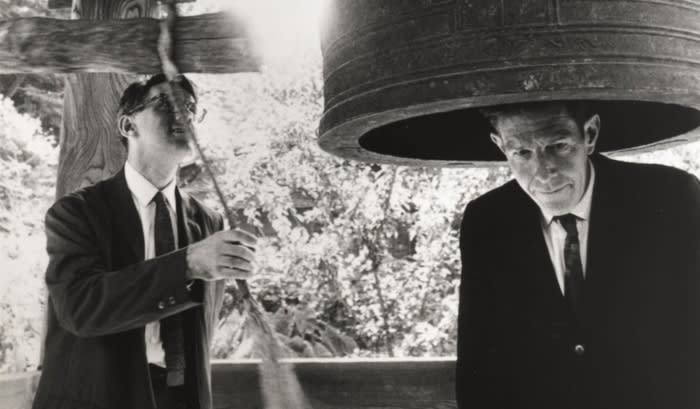

John Cage Ryoanji
Overview
An installation devoted to his celebrated Ryoanji series from 1983-1992, inspired by the rock garden at Ryōan-ji
Casting Light on Both the Audio and Visual Interpretations of the Most Influential Composer of Our Time
An Exhibition Uniting Musical Compositions and Drawings from John Cage’s Exquisite Ryoanji Series
“I think of the garden or the space for the fifteen stones as being four staves, or two pages - each page having two staves. And the staves are actually the area of the garden. Knowing the whole of it, I can find by chance operations where to put which stone.” John Cage
Uniting John Cage’s influential practice as a composer and visual artist, Galerie Thaddaeus Ropac Salzburg will present an installation devoted to his celebrated Ryoanji series from 1983-1992, inspired by the rock garden at Ryōan-ji (“Temple of the Peaceful Dragon”), a Zen Buddhist temple that Cage first visited in Kyoto, Japan in 1962. The exhibition presents a selection of his Ryoanji drawings alongside recordings of his Ryoanji compositions for various instruments, focusing on how Cage expressed his ideas and the garden’s sensibility in both his audio and visual interpretations. The accompanying exhibition catalogue John Cage: Ryoanji includes Cage’s writing on Ryoanji, an interview with him, a selection of his manuscripts and scores for the series and a new essay by the leading writer on Cage, James Pritchett. Curated by Julia Peyton-Jones in collaboration with the John Cage Trust, the show is concurrent with the gallery’s exhibition Robert Rauschenberg: Borealis 1988-92.
“This exhibition provides a fascinating insight into the mind and practice of John Cage. Its focus on what the Ryōan-ji Zen Garden meant to Cage as a philosophical idea brings to light how he interpreted this sensibility in both his drawings and music. The accompanying publication explores the unique processes that Cage used to transform the most simple of materials―stones, pencils, paper―into some of the most captivating and important music of all time.” Laura Kuhn, Founding Trustee and Executive Director of the John Cage Trust
“Beyond illuminating the artistic dialogue between longstanding friends and collaborators Robert Rauschenberg and John Cage, this exhibition of Cage’s remarkable Ryoanji series is above all an exquisite demonstration of how his artistic process makes the abstract tangible. With these compositions and drawings, Cage created a body of work with a palpable sense of the miraculous in the form of some of the most profound music of our time, and a series of drawings, noted by the renowned art critic David Sylvester to be ‘among the most beautiful prints and drawings made anywhere in the 1980s’.” Julia Peyton-Jones, Senior Global Director of Special Projects, Galerie Thaddaeus Ropac
DRAWING WITH STONES
In 1982, when Cage was commissioned to design the cover for a book to be published by Editions Ryôan-ji, he chose paper with the same proportions as the garden in Kyoto, placed a stone on it, then drew a pencil outline around it. The selection of 15 stones and their placement on the page were determined by chance operations for each drawing. This process resulted in a scale of densities of lines and curves according to the variety of stones and different pencils that were used.
“The method of these drawings provides an immediate, simple connection to the Ryoanji rock garden,” explains James Pritchett in his essay for the exhibition catalogue. “Taken as a series, Cage’s Ryoanji drawings are a concrete demonstration of the insight of his story about the garden: the emptiness of the space can indeed support stones at any points in it.” Yet of deeper significance than the stones themselves and their particular arrangement in the Ryoanji garden is the conception of the empty space from which all things arise: “All of what you see and hear in this room is really the product of the empty space, the silent duration of time. We are witnessing Cage’s realisation that if a space can be made truly empty―empty of our preconceptions, our beliefs, our narratives, our habits―everything can be discovered within it. These drawings and these musical compositions are gateways to that empty, silent space.”
The selection of Ryoanji compositions included in the installation will be played in a chance-determined sequence. Departing from the prescriptions of conventional musical notation, Cage’s innovations were founded on the principle of indeterminacy. He developed processes of chance-controlled creation, consulting the coin oracle of the I Ching and later computer-generating randomised numbers, reducing the subjective aspects of both composition and performance.
CAGE AND RAUSCHENBERG
Widely considered to be the most influential composer of our time, Cage’s inventive and unorthodox approach revolutionised contemporary music and his influence extended across a range of artistic spheres, encompassing visual art and dance. He was central to New York avant-garde circles, together with his partner the choreographer Merce Cunningham, forging close friendships with artists including Jasper Johns and Robert Rauschenberg. Cage’s most enduring and notorious composition, the radical 4′33′′ of 1952, in which the performer is instructed not to play their instrument, was inspired by Rauschenberg’s monochrome White Paintings (1951). Rauschenberg famously stated that he sought to work “in the gap between art and life”, a concept made manifest by his incorporation of found objects into his works. In an analogous way, Cage’s compositions drew upon the world around him. He used found objects in his compositions for prepared piano, which entailed placing a variety of household items on the instrument’s strings, while 4′33′′ heightens attentiveness to the ambient noise of one’s environment, breaking down the customary distinctions between musical and non-musical sound.












































































































































































